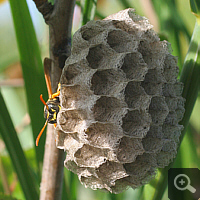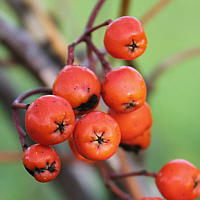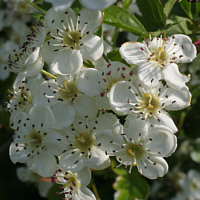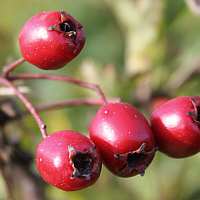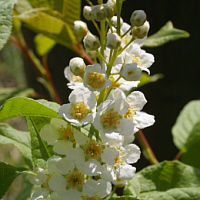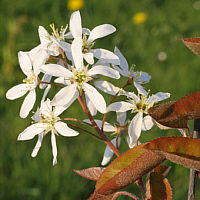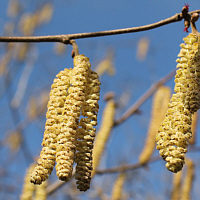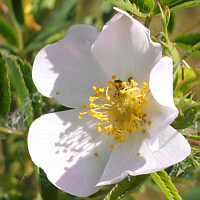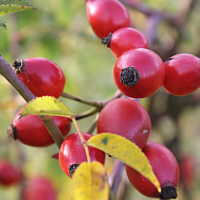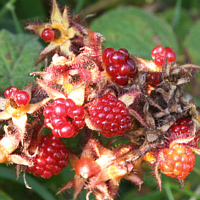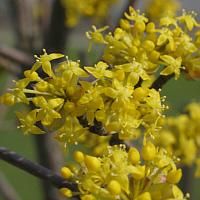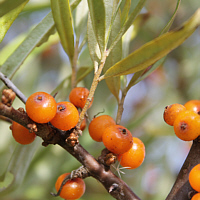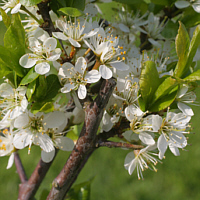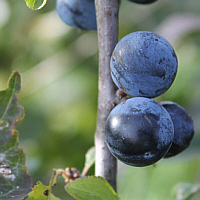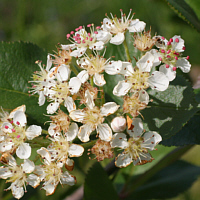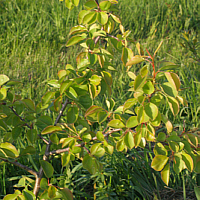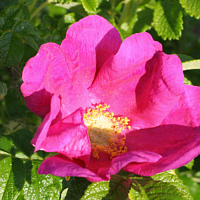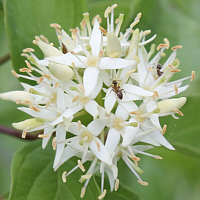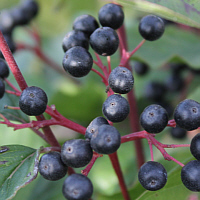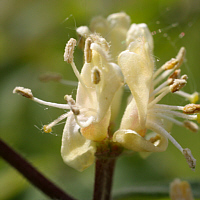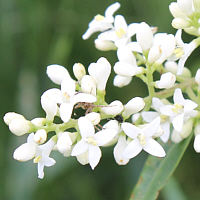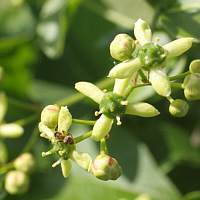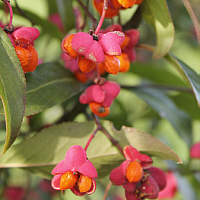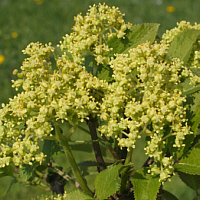Wild hedge
Overview
Planting of a wild hedge is worthwhile in many respects. An established wild hedge acts almost like a living organism and is an important biotope for many insects, birds and mammals. For the usage in a wild hedge are more than 40 indigenous bushes and small trees suitable, as well some conifers and foreign shrubs. With the right pruning the wild hedge becomes within a few years to a impenetrable draught and privacy shield. In addition, it pleases the owner with an opulent bloom in spring and also numerous, often edible fruits in autumn, which can be processed to marmalades, jams, jellies, chutneys, juices, syrups, liqueurs, schnaps, vinegar or teas. Many species are important honey plants, other species are also for other insects like butterflies of use. Fruits are not only eaten willingly by humans, also a number of birds and some mammals like squirrels are glad about the bountiful table. Furthermore, the wild hedge provides habitat and refuge for many birds, reptiles and mammals.
Planting of a wild hedge is moreover no expensive affair. Many tree nurseries and some provider on the internet offer wild hedge assortments with a price per bush of under 3 €. In this case, bushes are already distinctly over 50 cm high and grow up within a few years to a dense hedge. Best period for planting of wild hedge is late autumn (from end October to end November). Planting holes are excavated before purchase of the plants, because mostly plants are delivered bare-root, so not potted and without soil, and thus they have to be planted as soon as possible. Important is a strongly watering and carefully illuviation of the soil. As far as not yet occurred by the supplier, plants should be pruned 30 – 50%. In my case 95 – 97% of the bushes have survived their first winter and have driven out again next spring. Also in the next years a regular pruning is important to get dense and healthy plants.
Fructiferous species
Following species produce fruits that are also for humans edible.
European rowan or Mountain ash (Sorbus aucuparia)
The European rowan, a member of the Rose family (Rosaceae), is an unpretentious, small tree with a maximal growth height of nearly 15 metres. The European rowan has odd-pinnate leaves and produces in autumn orange-red berries, which are in opposition to the general opinion non-poisonous. Raw berries are relatively bitter and contain a lot of parasorbic acid, which can lead to indigestion. Rowans should be picked not until after frost influence (then they are less bitter) and then be boiled, by what the para sorbic acid is converted in the considerably more digestible sorbic acid. By the way, the name of the sorbic acid derives from the botanical generic name of the European rowan (Sorbus aucuparia). You can produce from the rowans a sourly jam, which fits well with venison.
Common hawthorn (Crataegus monogyna)
The Common hawthorn, a member of the Rose family (Rosaceae), reaches a height of circa 3 – 5 m, is acanthaceous and densely branching. The bush is well pruning-compatible. Ingredients of the hawthorn should act similarly as digitalis and are used today in medicine as preparations in the case of heart diseases. Fruits are sweet-sour and edible, but are not suited for fresh consumption because of their mealiness. However, because of their gelification ability they are suited well for an admixture to other wild fruits for making of jams and jellies. In addition, the hawthorn plays a role as larval host plant of some butterfly species.
Bird cherry or Hackberry (Prunus padus)
The native Bird cherry, a member of the Rose family (Rosaceae), grows up to a up to 10 m high tree, is fast-growing and produces in late summer ca. 1 cm great, black, in bunches of grapes arranged cherries, which are edible. The cherries taste sweet, but have sometimes a bitter aftertaste. Fruit pulp is non-poisonous, but seeds contain a poison, which is similar to the hydrocyanic acid.
Snowy mespilus (Amelanchier ovalis)
The Snowy mespilus, a member of the Rose family (Rosaceae), is naturally found especially at sunny and dry sites and reaches a height up to 4 metres. The pear-like leaves turn beautiful orange-red in autumn. In summer numerous violet berries are produced, which taste sweet-sour, but also floury, and from which jams are producible.
Japanese wineberry or Wine raspberry (Rubus phoenicolasius)
The Japanese wineberry, also called Wine raspberry, belongs to the raspberry genus (Rubus), a member of the Rose family (Rosaceae). Originally this plant comes from Northeast Asia (Japan, Korea, China), but is naturalised for a long time in Europe. The plant produces up to 3 m long, branched shoots, which are intensively covered with glandular hairs and spikes. In July ripen irregularly the half-round, circa 1 cm great, intensily bright red raspberries, which are surrounded by the rusty-red sepals. Fruits taste excellently, they are of a markedly good wine-sourly flavour. Similar to classic raspberries, blossom takes place at the two-year-old rods, which can then be cut out in autumn after harvest.
Greater European cornel (Cornus mas)
This slow-growing, maximal 8 m high bush from the Dogwood family (Cornaceae) is very pruning-compatible and ecologically valuable. The European cornel blossoms already in March or April, thus it is one of the earliest honey plants. In autumn are the circa 2 – 3 cm long, dark red, date-like cornel cherries ripe, which are very vitamin-containing and have a good taste of its own. The cornel cherries should be picked overripe. Efficient is a harvesting through striking off. For this purpose, a foil or sheet is covered under the bush and then is stricken at the branches with a stick. Overripe cornel cherries separate easily from the bush and fall to the ground. This harvest method must be repeated every few days, because cornel cherries ripe unevenly. From the cornel cherries are jams, jellies, juices and liqueurs producible.
Common sea-buckthorn (Hippophae rhamnoides)
The Common sea-buckthorn, a member of the der Oleaster family (Elaeagnaceae), combines even several advantages. First of all are to name the bright orange berries, which taste sourly and have a very high vitamin-content. They are well usable for juice, compote or jam. For a good harvest several specimens must be planted, because the Sea-buckthorn is dioecious. Hand-picking is inefficient, because berries burst easily and stain fairly. In addition it is a painful matter, because the Sea-buckthorn is armed with numerous thorns. In the case of some sorts the berries drop by full ripeness easily from the bush. Put a sheet or a foil under the to reaping branch and shake that or strike with a stick at the branch. A further harvesting method is flash freezing. For this purpose the with berries draped branches are cut off and put in the freezer. As soon as the berries are frozen, these let separate easily by shaking from the branch. Apart from an usage of its fruits, the Sea-buckthorn has a high ornamental value. The very undemanding plant becomes maximal 6 metres high and grows relatively sparsely. Leaves are olive tree-like grey gleaming. Inconvenient of the Sea-buckthorn is the pronounced propensity for formation of stolons.
Blackthorn or Sloe (Prunus spinosa)
The Blackthorn, also called Sloe, a member of the Rose family (Rosaceae), reaches a height of circa 3 m. The Blackthorn is a thorny, slow-growing bush, which is well pruning-compatible. In late autumn ripe the blue fruits, which are harvested not until after frost exposure. From the fruits are jams, juices and alcoholic beverages producible.
Black elderberry (Sambucus nigra)
The Black elderberry is a member of the Muskroot family (Adoxaceae) and can reach a height up to 11 m. In spring appear the corymbs, which are composed of countless small single flowers. The blossoms let utilize them manifoldly, also the black berries, which are mildly poisonous. Poisons are destroyed during cooking, so that elderberry juice or jelly can be savoured without any problems.
Wild cherry, Sweet cherry or Bird cherry (Prunus avium)
The Wild cherry is the wild-growing basic form of sweet cherries. It is a member of the Rose family (Rosaceae) and becomes an up to 25 m high tree. In contrast to the culture forms are the fruits of the Wild cherry black, small and relatively juice-poor. They are of a bittersweet taste and amongst birds highly coveted.
Sweet briar or Eglantine rose (Rosa rubiginosa)
The native Sweet briar or Eglantine rose, a wild rosen species, belongs of course to the Rose family (Rosaceae). It is intensively covered with prickles and reaches maximal 2 m height. In autumn are numerous, slender rosehips produced, from which tea or jam are producible. Especially the moist leaves smell of ripe apples.
European crab apple (Malus sylvestris)
The archetype of the culture apples from the Rose family (Rosaceae) grows up to a small tree. Leaves are mostly smaller than in the case of the culture forms. In May or June impresses the crabapple by its intensive white-pink blossoms, in autumn mature then small and yellow apples, which are not suited for a fresh consumption. Due to many stone cells are the fruits hard and juice-poor, what the crabapple has helped to its name. On the one hand are the fruits interesting for wild animals, on the other hand they let use them also for a steam juice extraction and liquors production. In nature has this basic form become very rare.
European wild pear (Pyrus pyraster)
The archetype of the culture pear from the Rose family (Rosaceae) grows up to a up to 20 m high tree. Between April to May impresses the European wild pear by its intensive white blossoms, in autumn mature then small and yellow pears, which are not suited for a fresh consumption. Due to many stone cells are the fruits hard and juice-poor, what the wild pear has helped to its name. On the one hand are the fruits interesting for wild animals, on the other hand they let use them also for a steam juice extraction and liquors production. In nature has this basic form become very rare and threatened with extinction. Probably do not exist genetic pure wild pear individuals anymore but only genetic slightly modified specimens, because the wild pear hybridizes easily with culture forms. Identification of a wild pear is difficult, because only the sum of several criteria differentiate that sure from an early culture form. One of these criteria is the formation of thorns at the branches. Similar structures are partly to be found admittedly in early culture forms too.
Thorny species
Thorny species have an important function as safe nesting site for birds.
Japanese rose or Ramanas rose (Rosa rugosa)
This rose species, a member of the Rose family (Rosaceae), originates originally in Japan. Albeit it is wild in Germany for long. Therefore it is a neophyte. The Japanese rose can reach a maximal height of 1,5 m, has numerous, large flowers and produces round rosehips. Because of its numerous stolons it has a disposition to a dense hedge formation.
Common buckthorn or Purging buckthorn (Rhamnus cathartica)
This native member of the Buckthorn family (Rhamnaceae) can become up to 4 m high and has an erect, somewhat maverick growth. The name of this bush is derived from the numerous, strong thorns. Caution: The berries are very poisonous.
In addition are the following fruit-bearing species also with thorns or spines equipped:
Common hawthorn (Crataegus monogyna), Dog rose (Rosa canina), Japanese wineberry (Rubus phoenicolasius), Common sea-buckthorn (Hippophae rhamnoides), Sloe (Prunus spinosa), Sweet briar (Rosa rubiginosa), European wild pear (Pyrus pyraster).
Other species
Apart from the fruit-bearing and thorny species are for the use in a wild hedge several additional species suited.
Grey willow (Salix cinerea)
The Grey willow, a member of the Willow family (Salicaceae), is well-suited for a use in a hedge, because it is a small willow species. It becomes maximal 4 metres high and shows free-standing a spherical growth form. As almost all willows is also this species very fast-growing and an important honey plant.
Alder buckthorn (Frangula alnus)
The 2 – 3 m high Alder buckthorn belongs to the Buckthorn family (Rhamnaceae) and prefers moist to wet sites. The name derives from the slightly foul-smelling bark, if this is moist.
Field maple (Acer campestre)
This great bush to small tree from the Soapberry family (Sapindaceae) has small, dark green, lobed leaves and is exceptionally pruning-compatible. In spring it is a good honey plant.
European fly honeysuckle or Dwarf honeysuckle (Lonicera xylosteum)
The European fly honeysuckle or Dwarf honeysuckle, a member of the Honeysuckle family (Caprifoliaceae), is widespread in Germany. The European fly honeysuckle is a rather delicate bush with a maximal growing height of 2 – 3 metres. Small, red berries are produced, which are mildly poisonous.
Common snowberry (Symphoricarpos albus)
The Common snowberry, a member of the Honeysuckle family (Caprifoliaceae), is native in North America. In this country it is mainly planted as ornamental shrub, but is also to be found in some regions in the wild and thus to be understood as neophyte. The Common snowberry is a rather delicate bush with a maximal growing height of 2 metres. It are small, white berries produced.
European spindle or Common spindle (Euonymus europaeus)
The European spindle or Common spindle is a circa 3 metre high, poisonous bush from the Staff vine or Bittersweet family (Celastraceae). Branches have cork slats, by what they appear square-shaped in cross-section. Specially attractive are the intensely-red autumn colouring of the leaves and also the purple-pink and orange coloured capsular fruits.
European hornbeam or Common hornbeam (Carpinus betulus)
The European hornbeam or Common hornbeam is a member of the Birch family (Betulaceae) and a classic hedge plant. Uncut it grows up indeed to a maximal 25 m high tree, but it is very pruning-compatible and branches due to a regularly pruning markedly densely. Remarkable is the late leaf fall. Dried leaves are not dropped before late winter.
Red elderberry (Sambuca racemosa)
The Red elderberry belongs to the Muskroot family (Adoxaceae). It can reach a height of circa 3 m and produces in autumn in bunch arranged, red berries, which are contrary to the berries of the Black elderberry unfit for human consumption. The Red elderberry is very frost-hardy but avoids lime.
Black alder, also European alder or Common alder called (Alnus glutinosa)
This member of the Birch family (Betulaceae) is rather less suited for an usage in a wild hedge because the Black alder grows up to a maximal 30 metres high tree. It prefers moist sites.
Wayfaring tree (Viburnum lantana)
The Wayfaring tree, a member of the Muskroot family (Adoxaceae), grows up to a dense, maximal 4 m high bush. It is mildly poisonous.

